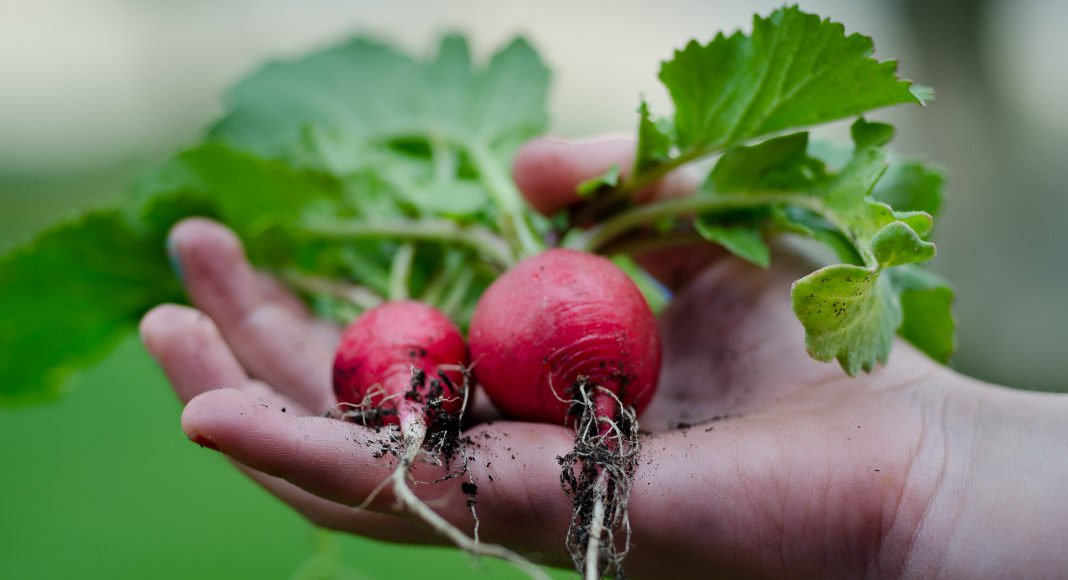 If April showers bring May flowers, then June definitely brings all the bugs. In Kansas, we have no shortage of trials and tribulations in the garden, but being armed with some basic tools and tricks that help keep insects in check can help us achieve that abundant harvest that we all long for.
If April showers bring May flowers, then June definitely brings all the bugs. In Kansas, we have no shortage of trials and tribulations in the garden, but being armed with some basic tools and tricks that help keep insects in check can help us achieve that abundant harvest that we all long for.
Educate Ourselves on Common Vegetable Garden Pests & Beneficial Insects
Once we have our garden in the ground, it’s time to do a little research on the crops we chose so that we know what insects may decide to wreak havoc on our vegetables. K-State has a fantastic resource with many crop-specific PDFs that outline growing conditions and possible insect issues. We should familiarize ourselves with the most common garden pests (aphids, spider mites, cabbage loopers, and squash bugs are just a few examples) so we know what they look like at different life stages and can identify accordingly.
Just as important, be sure to know what beneficial insects might be encountered. Praying mantis, ladybugs and green lacewings are all excellent garden companions (they eat the bad bugs!), so being able to identify these guys accurately is important so we don’t accidentally think we have a pest problem.
Monitor the Garden Regularly
Once we are aware of common pests that may appear in our gardens, we must monitor plants often. We’ll be out there tending the garden anyway, so while we are there, let’s look closely at plants to see signs of insects: eggs (often on the undersides of leaves), actual insect larvae or adults present, plant damage such as holes in leaves, stipled or stripped leaves, or even insect poop. Closely scouting the garden will mean that we can discover problems before they have a chance to reach infestation status, and those are much easier to rectify.
Utilize Cultural and Mechanical Control Techniques
In the professional world of horticulture, there’s a really effective system, or set of guidelines, called Integrated Pest Management (IPM). These practices are easily translated to the home garden. They include many of the tips outlined here, starting with awareness and education of potential pest issues, as well as close monitoring of garden crops.
Cultural and mechanical controls are ways we can alter our gardening environment to make it a less hospitable place for pests to thrive.
Some examples of cultural control are simple measures like watering timing, proper plant nutrition, and crop rotation. When crops are watered at night, moisture takes longer to evaporate. Dark, damp environments are breeding grounds for plant diseases.
Proper plant nutrition is another key. Using nutrient-rich soil is paramount to any healthy garden, and this can be achieved by regularly adding organic matter like compost. Non-chemical fertilizers (Espoma, Fox Farm and Nature’s Source are just a few examples) provide additional nutrition to set plants up for success. Healthy, thriving plants are less susceptible to insect damage.
In addition, crop rotation (either from year to year or season to season) can vastly reduce insect populations in the garden. Many insects overwinter in garden debris, and if we plant the same exact crop in the same spot, they’ve got it made. Moving things around a bit makes it harder for these overwintered pests to establish.
A few examples of mechanical control include weeding to minimize alternate host plants, installing bug screen over raised beds, or putting chicken wire around an in-ground bed that might otherwise succumb to rabbits or other critters.
Use Insecticides as a Last Resort
This isn’t to say we should never treat our gardens to control insects, because the bugs will come during a Kansas summer. Rather it means to use some of the aforementioned techniques before reaching for an insecticide and being super mindful about what, when and how we’re treating the food we will eventually be consuming.
Look for organic products, preferably ones that are OMRI certified. Here are a few examples:
Diatomaceous Earth
This is a powder that can be sprinkled on garden crops to control crawling insects.
Spinosad
This is a bacteria-based insecticide that is a great tool for maintaining organic gardens. It can effectively control things like caterpillars, thrips, spider mites, and asparagus beetles. One popular brand is Captain Jack’s Deadbug Brew by Bonide.
Dr. Bronner’s Peppermint Castile Soap
Diluting one tablespoon in a quart of water and spraying on garden plants can help smother small bugs like aphids, thrips, and spider mites, as well as other insect eggs and larvae.
Bacillus thuringiensis (Bt)
This is another bacterial insecticide that is very effective at controlling all kinds of caterpillars.
Neem Oil
Extracted from the Neem tree in India, this foliar spray can help with both insect and fungus problems. One popular brand is Monterrey’s 70% Neem Oil concentrate.
Some Notes about Insecticides
It’s imperative to thoroughly read, understand, and follow all labeling on any product. Be sure not to apply these products on especially hot or windy days to reduce volatility and drift to unwanted areas. Don’t apply them during the hottest part of the day (evening is actually ideal).
Natural insecticides are contact killers, meaning they are not absorbed by the plant and must come into contact with the bugs we want to treat. Thorough application of all plant surfaces, including the undersides of leaves, is important to gain effective control.
Consider possible harvest times and keep that in mind when applying insecticides. Some labeling will offer a window of time that should pass between spray to harvest. Make sure to thoroughly spray plants with plain water before harvesting after an insecticide application.

















Spinosad kills bees.
http://npic.orst.edu/factsheets/spinosadgen.html#products